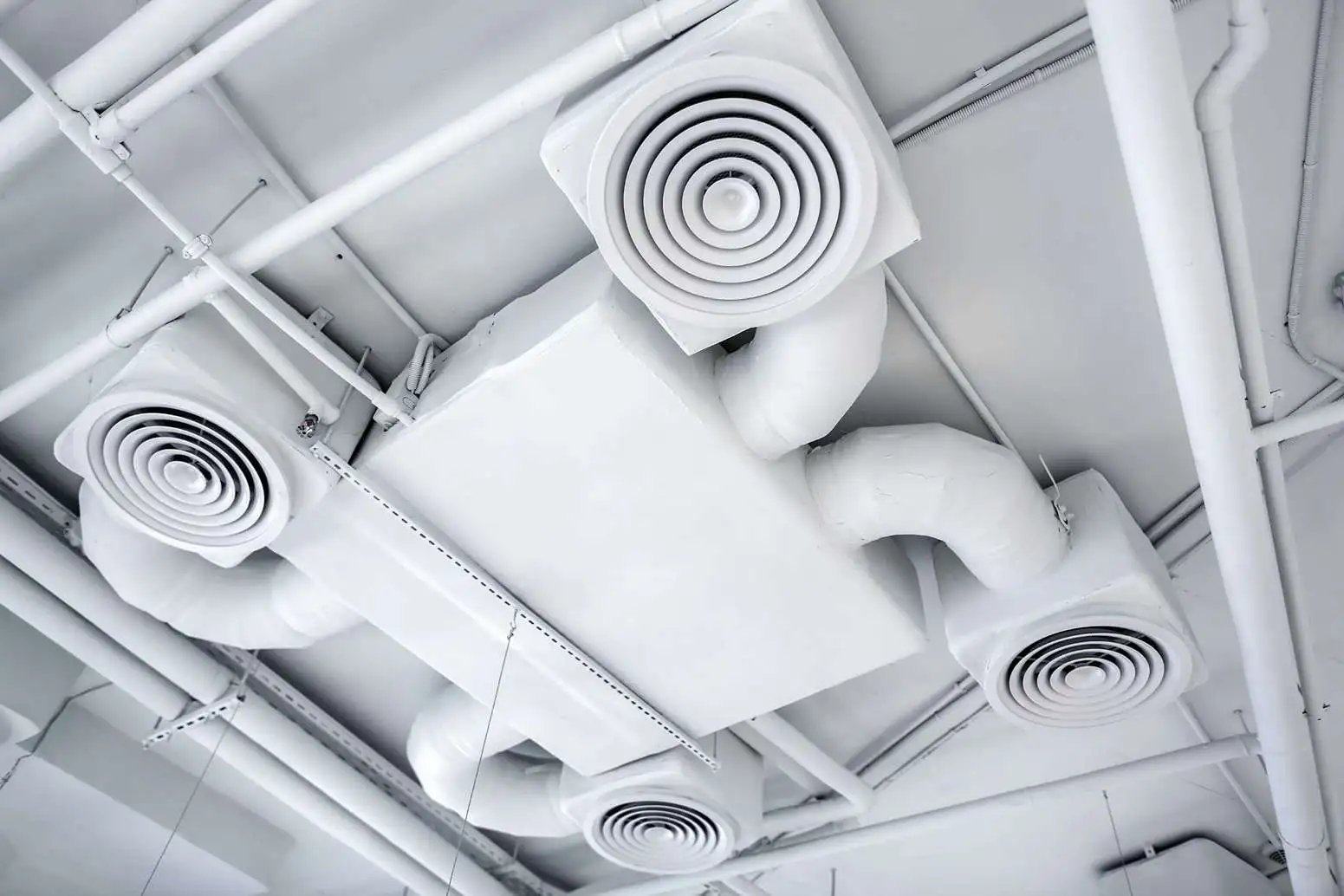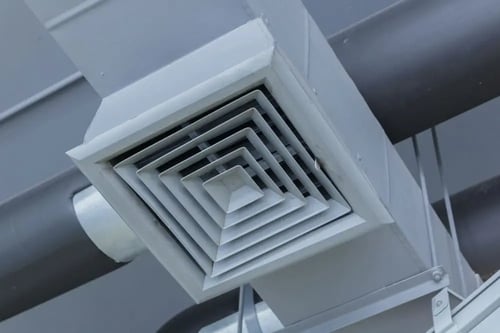Constant Air Volume and Variable Air Volume: Difference

In the modern world, the building sector demands comfort and energy efficiency. The design of heating, ventilation and air conditioning (HVAC) systems has a significant impact on both, and working with a qualified engineering firm has a positive impact on the final outcome.
A key decision in HVAC design is selecting an adequate air-handling configuration: constant air volume (CAV) or variable air volume (VAV). Each option has advantages and disadvantages, and using the right configuration enhances comfort and efficiency.
This article provides an overview of CAV and VAC systems, describing the principles and calculations used by HVAC engineers during the design process.
Get an HVAC design that meet the needs of your building.
Constant Air Volume Systems
CAV systems keep a constant airflow, as their name implies, and the desired indoor conditions are reached by adjusting the air supply temperature. For example, when a building requires a higher cooling output on a hot summer day, the CAV system delivers colder air. In chilled water systems, the cooling effect depends on the cold water flow delivered to the fan coil unit. In turn, the water flow controller operates based on the thermostat settings.
CAV systems can be of single-zone or multi-zone types, although they are better suited for single-zone applications where the load experiences minimal change over time. Some examples are auditoriums, theaters and museums. Multi-zone CAV systems require duct heating to deliver different air temperatures for individual zones, which reduces their energy efficiency.
The operation of a multi-zone CAV system can be described best with an example. Consider the following design conditions:
-
An indoor air-handling unit (AHU) serves three zones (A, B and C).
-
Each of the three zones has a dedicated thermostat.
-
The AHU gets cold water from a chiller with a cooling tower.
-
Air duct heaters are attached to the main branches serving individual zones.
-
The thermostats are set at 55°F (A), 68°F (B) and 72°F (C).
-
The AHU delivers cool air at 55°F.
Once the supply air enters the duct system, it can only be heated and not cooled. Therefore, it must be supplied at the lowest of the three temperatures required - 55°F for zone A in this case. After zone A is served, the air flow can be heated to the temperatures required for other zones: 68°F for zone B and 72°F for zone C.
Although the operating principle is simple, it has an efficiency limitation. Part of the cooling output is wasted when air is reheated for zones B and C, and the duct heaters themselves also consume energy.
Variable Air Volume Systems
As you might guess, VAV systems keep the air temperature constant, and instead they adjust airflow depending on the load. VAV systems can have single-zone, multi-zone or dual duct configurations. Just like CAV is the preferred option in single-zone systems, VAV is recommended for multi-zone systems.

Dual duct VAV systems have separate ducts for hot and cold air, and each zone has a plenum where their airflow is mixed. The ratio of hot and cold air depends on the desired temperature for each particular zone. This HVAC configuration is the most expensive in terms of installation, operation and maintenance.
Multi-zone systems have VAV boxes that control the airflow supplied to individual zones. Unlike CAV, the cold water flow supplied to the fan coil unit is kept constant. VAV systems achieve their full potential in applications where there a multiple zones with variable load. Some examples are malls, hotels and office buildings.
VAV boxes have a role similar to the duct heaters used in a CAV system. Instead of reheating air according to the needs of each individual zone, the airflow is controlled while keeping temperature constant.
Basic Calculations in CAV and VAV Design
The HVAC design process involves complex calculations and energy modeling. However, the equations that describe system operations are simple. This section describes how temperature and airflow are adjusted according to load.
The starting point is the sensible heat gain equation, which is fundamental in HVAC systems:
- Q = 1.08 x CFM x ΔT
Where:
- Q = Load of the room or zone being served (BTU / hour)
- CFM = Airflow in cubic feet per minute
- ΔT = Difference between the room temperature and the supply air temperature
Example 1 - VAV System
Let’s assume that a room has a load (Q) of 10,000 BTU/h, with an indoor temperature of 75°F and a supply air temperature of 55°F. In this case, the difference is 20°F. To calculate the required airflow, the sensible heat equation can be rearranged:
- Q = 1.08 x CFM x ΔT
- CFM = Q ÷ (1.08 x ΔT)
- CFM = 10,000 BTU/h ÷ (1.08 x 20°F) = 463 cfm
In this case, the VAV system would have to adjust airflow to 463 cfm for the corresponding zone. Let’s observe the effect when the load is increased to 12,000 BTU/h.
- CFM = 12,000 BTU/h ÷ (1.08 x 20°F) = 555 cfm
The temperature difference of 20°F is kept constant under a load of 12,000 BTU/h, while increasing airflow to 555 cfm.
Example 2 - CAV System
In this case, the cooling load and room temperature are the same used in the example above: 10,000 BTU/h and 75°F. However, the airflow is fixed at 500 cfm and the air supply temperature is adjusted. The sensible heat equation would be rearranged as follows:
- ΔT = Q ÷ (1.08 x CFM)
- ΔT = 10,000 BTU/h ÷ (1.08 x 500 cfm)
- ΔT = 18.52°F
The air supply must be 18.52°F below room temperature, which is equivalent to 56.48°F. Repeating the calculation for 12,000 BTU/h, the following result is achieved:
- ΔT = Q ÷ (1.08 x CFM)
- ΔT = 12,000 BTU/h ÷ (1.08 x 500 cfm)
- ΔT = 22.22°F
In this case, the required air supply temperature is 52.78°F.
Conclusion
HVAC engineers can choose between CAV and VAV systems depending on the application. While a CAV system uses variable air temperature and constant airflow, a VAV system keeps constant temperature and variable airflow. CAV systems are better suited for single-zone applications where the load experiences little change, while VAV systems are the best option for multi-zone applications with a constantly changing load.
Make sure your mechanical installations are code compliant and energy efficient, while getting a 50% faster turnaround. You can contact Nearby EngineersNew York Engineers by email (info@ny-engineers.com) or phone.

Michael Tobias
Michael Tobias, the Founding Principal of NY Engineers, currently leads a team of 50+ MEP/FP engineers and has led over 1,000 projects in the US
Join 15,000+ Fellow Architects and Contractors
Get expert engineering tips straight to your inbox. Subscribe to the NY Engineers Blog below.



